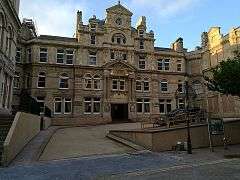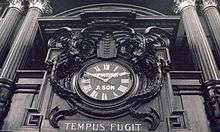Coal Exchange
| The Coal Exchange | |
|---|---|
| Y Gyfnewidfa Lo | |
 | |
 | |
 Location within Cardiff | |
| Former names | The Coal and Shipping Exchange |
| Alternative names | The Exchange Hotel |
| General information | |
| Architectural style | French Renaissance |
| Town or city | Cardiff |
| Country | Wales, United Kingdom |
| Coordinates |
51°27′56″N 3°10′06″W / 51.46544°N 3.1682°WCoordinates: 51°27′56″N 3°10′06″W / 51.46544°N 3.1682°W |
Listed Building – Grade II* | |
| Official name | Cardiff Exchange Building |
| Designated | 19 May 1975 |
| Reference no. | 13744[1] |
| Construction started | 1884 |
| Completed | 1888 |
| Design and construction | |
| Architect | Seward & Thomas |
The Coal Exchange first opened as the Coal and Shipping Exchange was a market floor for trading in coal in Cardiff, Wales. It is situated in Mount Stuart Square in Butetown, and was for many years the hub of the city's prosperous shipping industry. It later became a music venue, with offices remaining in use in the West Wing, before being closed indefinitely in 2013 due to building safety issues. Following a series of proposals to demolish the building, Cardiff Council purchased the Coal Exchange, and in 2016 it was announced that the building was to be fully refurbished as a hotel, with a museum detailing the history of the building and of the Cardiff Docks.[2]
History

Before the Coal Exchange was built in Mount Stuart Square, the area was a residential square with a central garden. It was taken over by commerce as the city grew in prosperity. Coal merchants used to chalk up the changing prices of coal on slates outside their offices or struck deals in the local public houses.[3]
As Cardiff became the biggest coal port in the world, the building was constructed between 1884 and 1888 by Edwin Seward as a base from which to conduct trade negotiations regarding the coal mines of the South Wales Valleys – most of which was shipped to Cardiff for distribution.

The building played an important role in the industrial Cardiff of the 19th century. Paired Corinthian columns, an oak balcony, and rich wood panelling adorn the trading hall, which was reconstructed by Edwin Seward in 1911.[4]
Following its opening, coal owners, ship owners and their agents met daily on the floor of the trading hall where agreements were made by word of mouth and telephone. During the peak trading hour of midday to one o'clock, the floor might have as many as 200 men gesticulating and shouting. It was estimated that up to 10,000 people would pass in and out of the building each day. At one time the price of the world's coal was determined here.[3]
It was at the Coal Exchange that the first ever £1,000,000 cheque was signed[4][5] in 1904.[6]
Post-war period
Cardiff's reliance on coal made the Bute Docks highly vulnerable to any downturn in the demand for it. With the end of the war the docks went into further decline. The Coal exchange closed in 1958 and coal exports came to an end in 1964.
The building became Grade II* listed in 1975.[7]
In 1979 the Coal Exchange was earmarked as a future home of the proposed Welsh Assembly[3] and a heavily reinforced underground carpark was constructed (also envisaged to act as a nuclear shelter)[8] but the plan for devolution was rejected by the Welsh people in a referendum. In 1983 the building was considered as a headquarters for the Welsh language television station, S4C,[8] though this also failed to take off. The Exchange Hall was used with great regularity during this period as a filming location for various parts of the entertainment industry, for example the BBC drama Bevan.[8]
Re-opening, closure and current status
In 1988 the building was re-acquired and subsequently completely refurbished in 2001 to turn it into a major venue. The venue hosted acts such as the Arctic Monkeys, Manic Street Preachers, Ocean Colour Scene, Stereophonics and Biffy Clyro.[9]
The Coal Exchange closed indefinitely on 7 August 2013 as a result of building safety issues. With the subsequent liquidation of the company which owned it in 2014, ownership of the Coal Exchange passed to the Crown Estate. It is currently the subject of ongoing efforts to preserve the historic fabric of the building by the not-for-profit organisation Save the Coal Exchange Limited.[10] In February 2015, Welsh Government Economy Minister Edwina Hart commissioned a feasibility study into future re-use of the building. In May 2015 it was confirmed that the exchange would be used for filming of the remake of The Crow. In 2016, filmmaker Nick Broomfield visited the building as part of his documentary Going Going Gone, which investigated the deterioration and heritage of the Coal Exchange.[11][12] In June 2017, the BBC broadcast a documentary entitled Saving The Coal Exchange, which looked at the development of the building into a luxury hotel.[13]
The Exchange Hotel
In 2016 it was announced that the building was to be fully refurbished as a hotel by private company Signature Living, with a museum detailing the history of the building and of the Cardiff Docks.[14] The proposal received some opposition, including from the Victorian Society[15] and MP Stephen Doughty.[16] Cardiff council granted planning permission in July 2016. The hotel opened in May 2017.[17] It offers 200 bedrooms, restaurant, spa facilities.[18] The restoration retained the original structure, including a number of original features including a memorial dedicated to World War I and the grand hall, previously the trading floor.[19][20][21]
Access
Coal Exchange is served by Cardiff Bay railway station and Cardiff Bus service 7, 8, 35, and Baycar.[22]
See also
References
- ↑ British Listed Buildings Cardiff Exchange Building http://www.britishlistedbuildings.co.uk/300014015-cardiff-exchange-building-butetown#.WR2WnPnx6Ul, Cardiff Exchange Building Check
|url=value (help). Retrieved 16 May 2017. Missing or empty|title=(help) - ↑ "Cardiff's Coal Exchange saved in £40m hotel revamp". BBC News. Retrieved 15 April 2016.
- 1 2 3 "South East Wales | Coal Exchange and Mountstuart Square". BBC. 4 November 2009. Retrieved 10 June 2012.
- 1 2 "History". Coal Exchange. Retrieved 27 October 2016.
- ↑ "Derelict railway building on top 10 at-risk buildings", BBC News, 14 September 2016.
- ↑ "Talks to secure future of Coal Exchange in Cardiff Bay", BBC News, 20 January 2014. Retrieved 27 October 2016.
- ↑ Cardiff Exchange Building, Butetown, British Listed Buildings. Retrieved 21 March 2013.
- 1 2 3 Evans, Catherine; Dodsworth, Steve; Barnett, Julie (1984), Below the Bridge: A photo-historical survey of Cardiff's docklands to 1983, Cardiff: National Museum of Wales Cardiff, pp. 37–38, ISBN 0-7200-0288-5
- ↑ "Open Mic | Cardiff Coal Exchange". Openmicuk.co.uk. Retrieved 10 June 2012.
- ↑ Save the Coal Exchange http://savethecoalexchange.com/. Retrieved 24 May 2015. Missing or empty
|title=(help) - ↑ Nick Broomfield: ‘I’ve always been fascinated by buildings and history’ The Guardian, article 1 May 2016
- ↑ "Going Going Gone". Internet Movie Database. Retrieved 22 May 2017.
- ↑ Saving the Coal Exchange BBC One Programme Listing, accessed 14 June 2017
- ↑ "Cardiff's Coal Exchange saved in £40m hotel revamp". BBC News. Retrieved 15 April 2016.
- ↑ Cardiff Coal Exchange plan unacceptable – Victorian Society BBC.coluk, article 4 July 2017
- ↑ An MP has raised serious concerns over how Cardiff's Coal Exchange was handed to a private developer www.walesonline.co.uk, article 8 April 2016
- ↑ Cardiff's Coal Exchange hotel will open its doors for the first time this weekend www.walesonline.co.uk, article 16 May 2017
- ↑ Outline Plans for the Coal Exchange www.exchangehotelcardiff.co.uk. Retrieved 16 May 2017
- ↑ The Exchange Hotel: The Old Coal Commodity House Now A Luxury Hotel In Cardiff's Port Revival Forbes, article 29 March 2017
- ↑ Hotels and Resorts to Travel to in 2017 The New York Times, article 5 January 2017
- ↑ 20 UK hotels, rooms and hostels opening in 2017 The Guardian, article 21 January 2017
- ↑ "Location". Coal Exchange. Retrieved 10 June 2012.
External links
![]() Media related to Coal Exchange at Wikimedia Commons
Media related to Coal Exchange at Wikimedia Commons